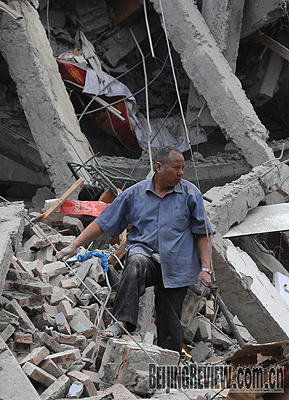|
 |
| MY HOME: A man in Dujiangyan City searches for salvageable things from the ruins of his home |
On the afternoon of May 12, a sudden trembling startled office workers in high-rise buildings in cities of central and west China. As the floors and walls of their buildings shook, people rushed out into the streets. As the shaking passed, relief began to set in that the earthquake had been relatively mild, but thousands of miles away the same quake had already claimed tens of thousands of lives. Later, as news of the event spread across the country, people would unite in grief and determination to save as many people as possible.
A major earthquake measuring 7.8 on the Richter scale jolted Wenchuan County in southwestern Sichuan Province at 2:28 p.m. With a population of 111,800, Wenchuan lies in the southeastern part of the Aba Tibetan-Qiang Autonomous Prefecture, 146 km northwest of Chengdu, the provincial capital of Sichuan. As the county with the largest economy under Aba, Wenchuan is also home to the Wolong Nature Reserve, China's leading research and breeding base for endangered giant pandas.
The earthquake was so strong that the shocks were felt in 16 provinces, municipalities and autonomous regions in western, northern, central and eastern areas of China. Forty-four counties and districts in Sichuan were severely affected by the quake. About half of the 20 million population in these areas were directly affected by the quake. The earthquake had also led to casualties in neighboring provinces of Gansu, Shaanxi, Henan, Yunnan and Chongqing Municipality.
In two hours, Chinese President Hu Jintao issued an order to make saving lives the top priority of relief work. Premier Wen Jiabao immediately boarded a plane bound for Chengdu in the evening.
Rescue work hindered
Explaining the destructiveness of the earthquake, Zhang Guomin, a researcher at the Institute of Earthquake Science under the China Earthquake Administration, said the focus of the intraplate earthquake was close to the earth's surface.
Zhang said there is an average of 18 earthquakes each year measuring at or above 7 magnitude on the Richter scale around the world, with one or two above a magnitude of 8. China, located on the plate interface between the Indian Ocean and the Pacific Ocean, is an earthquake-prone country. Wenchuan is located on a north-south earthquake belt that runs from northwest Ningxia Hui Autonomous Region to southwest Yunnan Province.
Wang Erqi, a researcher at the Institute of Geology and Geophysics under the Chinese Academy of Social Sciences, said the reason that people in a vast region sensed the earthquake is that Wenchuan is located on solid rock, which enables the aftershocks to spread very far.
Frequent aftershocks posed another challenge to rescue work. Immediately after the earthquake, the China Earthquake Administration revised the rating of the earthquake from 7.6 magnitude to 7.8 magnitude on the Richter scale. Sun Shihong, Chief Forecaster at the China Earthquake Networks Center, said during an interview on May 14 that there was a possibility the official rating could be revised again.
Sun said that unlike earthquakes caused by two neighboring tectonic plates slipping relative to each other, which produce few aftershocks, the Wenchuan earthquake did not release tectonic energy during the first major quake, so the aftershocks could last for one to two months. According to a report by the China National Radio, by the morning of May 14 over 3,000 aftershocks had occurred, three of which were over 6 magnitude on the Richter scale.
 |
|
TEAM WORK: Rescuers carry away a student dug from the collapsed building of a middle school in Mianzhu City for emergency medical treatment |
In less than three days after the earthquake, 119 aftershocks above 4 magnitude on the Richter scale had been monitored in Wenchuan, which hampered rescue work, causing more casualties and injuries.
| 